A well-designed website is essential for every therapy business in the modern digital era. A therapy website frequently serves as their initial point of contact with prospective clients. Consequently, a good therapy website that prioritizes the needs of their client may greatly improve user experience, foster confidence, and increase conversion rates. Additionally, a great therapy website incorporates high-quality images, readable content fonts, and clear call-to-actions to further enhance its effectiveness.
In this post, we’ll look at 9 therapy websites that put a strong emphasis on client-centered design and go over recommended practices for making successful therapy websites.
Why Client-Focused Design Matters
Enhancing User Experience
A client-focused website design is essential for enhancing user experience. When potential clients visit a practice website, they should be able to navigate easily and find the information they need quickly, especially when seeking counseling services.
A well-designed website improves navigation, making it easier for users to browse through services, read about the doctor, and book appointments. This not only enhances user satisfaction but also increases the likelihood of clients returning to the website.
Building Trust and Credibility
A professional and client-focused website design builds trust and credibility with potential clients, especially for mental health professionals. First impressions matter, and a clean, well-organized website can convey a sense of professionalism and care.
Features such as client testimonials, detailed information about the therapist, and educational content can help build trust and establish the therapist as a credible and reliable healthcare provider.
Improving Conversion Rates for Potential Clients
Effective therapist website design can lead to higher conversion rates. Clear call-to-actions (CTAs), easy-to-find contact information, and streamlined appointment booking processes make it easier for potential clients to take the next step.
By focusing on client needs and providing a seamless online experience, therapists can increase appointment bookings and inquiries, ultimately growing their practice.
Key Elements of Effective Practice Website Design
Clean and Professional Layout
A clean and professional layout is crucial for making a positive first impression for website visitors. A great therapist website should have a visually appealing design with a clear structure that guides users through the menu items, content and health services section.
Avoid clutter and ensure that important information is easily accessible. Always include social media icons and links, and consider a google map. Here’s an example of a clean layout:
Mobile Responsiveness
In today’s world, most people access websites via their mobile devices, making it crucial for practice websites to be both mobile and desktop friendly. A mobile-responsive design ensures that your website adapts seamlessly to different screen sizes, providing an optimal viewing experience whether clients are browsing on a smartphone, tablet, or desktop.
Prioritizing mobile design ensures that users have a smooth and intuitive experience, no matter how they access a site. This approach not only enhances user satisfaction but also boosts a site’s SEO ranking, as search engines favor mobile-friendly websites. Here’s an example of a responsive design:
Easy Navigation
Intuitive navigation is essential for a client-focused website. The navigation menu should be simple and organized, allowing users to find the information they need without any hassle.
Consider using a drop-down menu for different services your practice offers and include a search bar for quick access. Here’s an example of easy navigation:
Mobile Responsiveness
With the increasing use of mobile devices, having a mobile-responsive design is more important than ever. A mobile-friendly website ensures that users have a seamless experience regardless of the device they are using.
Responsive design adapts the website layout to fit different screen sizes, providing a consistent user experience. Here’s an example of a responsive design:
Client Testimonials
Client testimonials play a crucial role in building trust in the best relationship therapy center websites. Featuring testimonials on the website can provide social proof and reassure potential clients about the quality of care.
Include testimonials in a prominent location, such as the homepage or a dedicated testimonials page. It’s also helpful to pair the testimonials with a delightful image that reinforces the positivity. Here’s an example of embedded testimonials:
Clear Call to Action (CTAs)
Clear and compelling CTAs (call to action) are vital for guiding users towards taking action. Whether it’s booking an appointment, signing up for a newsletter, or contacting the practice, call to action buttons should be prominently displayed and easy to find within a neat layout.
Use action-oriented language and ensure that CTAs stand out visually and convert site visitors into more clients. Here’s an example of effective CTA placement:
9 Client-Focused Practice Website Design Examples
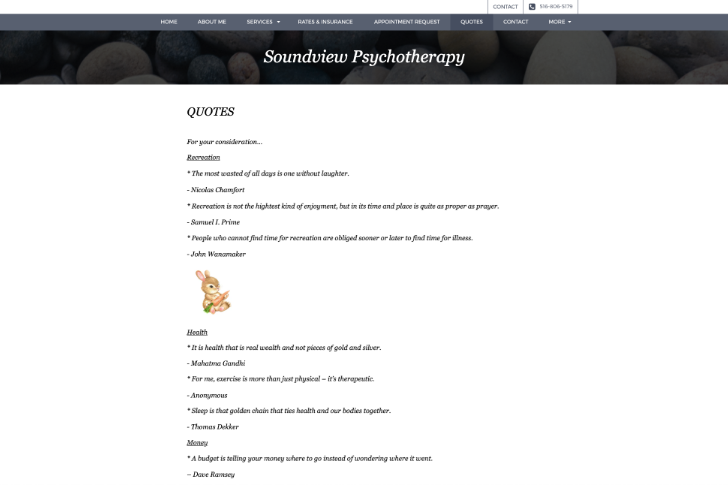
1: Soundview Psychotherapy
Website: Soundview Psychotherapy
Feature to Note
Soundview Psychotherapy website has a featured page dedicated to providing inspirational quotes for their client base, including those seeking individual therapy.
By having a page that addresses concerns such as money, health, relationship, and spirituality, it provides a safe haven for those seeking to find comfort in their personal lives, which in turn shows the client how much the practice cares for their wellbeing.
This personalized approach not only makes the website memorable but also distinctive, and in turn cultivates feelings of comfort and trust encouraging clients to choose their practice knowing their needs will be met.
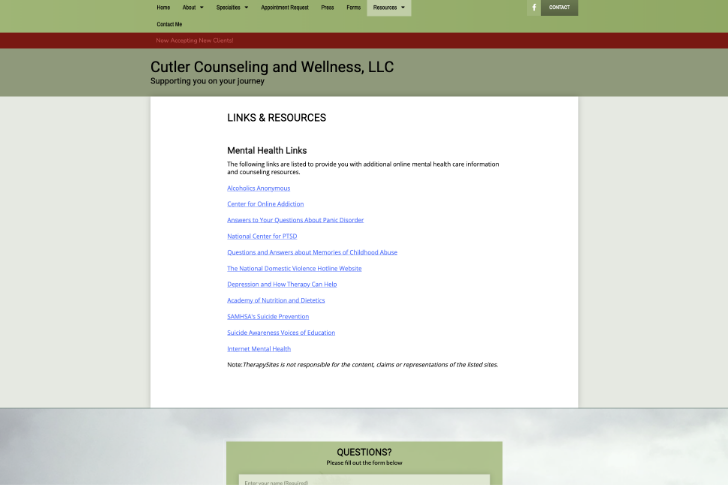
2: Cutler Counseling and Wellness, LLC
Website: Cutler Counseling and Wellness, LLC
Feature to Note
Cutler Counseling and Wellness, LLC’s website has a page dedicated to mental health links that provide clients additional online health care information and useful counseling resources, which is particularly beneficial for those practicing online therapy. Which in turn can be used as another resource that their clients can refer to when exploring other resources that can be an aid towards recovery.
Which in turn makes it simpler for therapists to direct their clients to resources they can use outside of a therapy session that can be discussed in a follow up session.
This convenience enhances the user experience for client education and can lead to higher conversion rates, as clients are more likely to return to and complete therapy session knowing this practice has their best interests at heart.
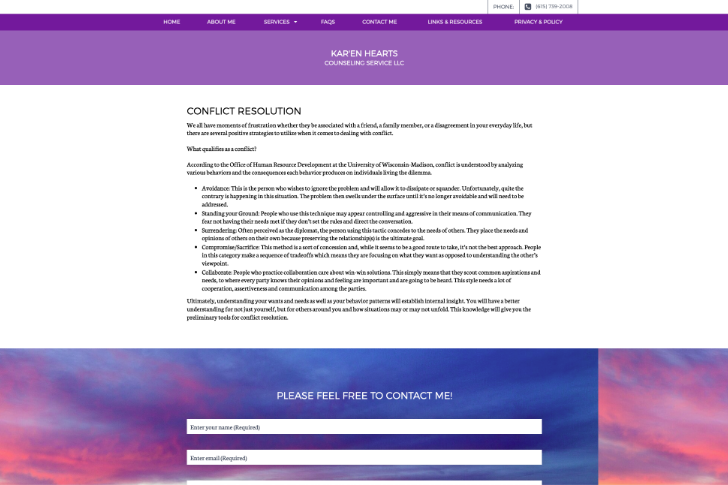
3: Kar’en Hearts Counseling Service LLC
Website: Kar’en Hearts Counseling Service LLC
Feature to Note
Kar’en Hearts Counseling Service LLC does an excellent job on providing clients with a resource on treated conditions, including family therapy. This section features areas of concern that the client may have when faced with conflict, as well as answers to common concerns on how they can overcome these sensitive factors when they arise in their daily lives.
By offering educational definitions, examples and preventive measures, the website empowers clients with a road map, helping them make informed decisions about their mental health.
By emphasizing education, the practice promotes itself as an informed and trustworthy partner in the wellbeing of its clients.
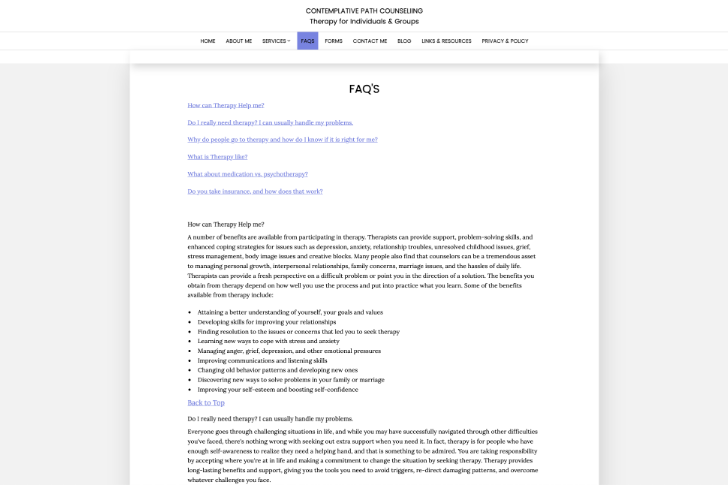
4: Contemplative Path Counseling – Therapy for Individuals & Groups
Website: Contemplative Path Counseling – Therapy for Individuals & Groups
Feature to Note
Contemplative Path Counseling website features an FAQ section that addresses common concerns clients may have before scheduling an appointment with a marriage and family therapist. This section provides a detailed overview of the conditions they treat and how to book an appointment.
By offering this FAQ section, it helps make scheduling a therapy session more accessible for potential clients, demonstrating the practice’s dedication to openness and client empowerment.
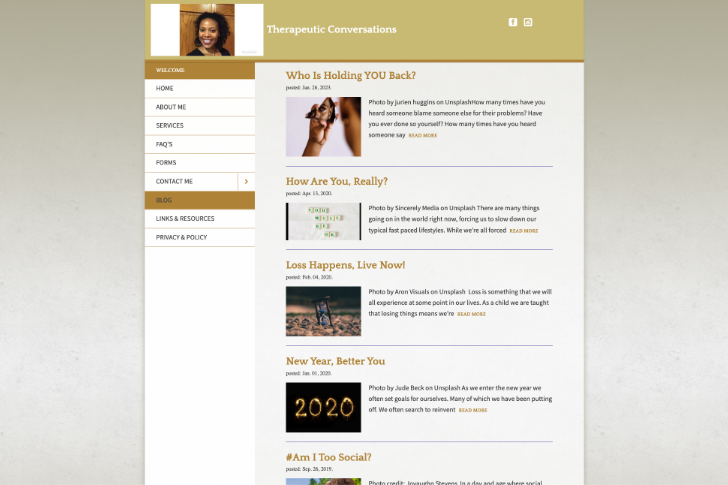
5: Therapeutic Conversations
Website: Therapeutic Conversations
Feature to Note
Therapeutic Conversations features an active blog section that regularly publishes articles on various mental health topics, including therapist website examples. This commitment to providing fresh, relevant content helps keep clients stay informed about, general wellness, and resource for overcoming any obstacle.
By sharing meaningful knowledge through blog posts, the practice positions itself as a thought leader in the field, fostering both engagement and community. In addition to educating clients, this constant information flow improves SEO, which raises the website’s search engine ranking and draws more visitors—a critical component of online marketing.
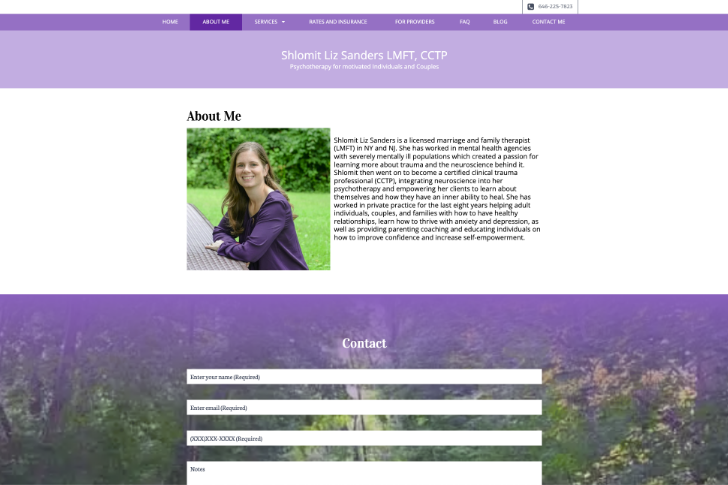
6: Shlomit Liz Sanders LMFT, CCTP
Website: Shlomit Liz Sanders LMFT, CCTP
Feature to Note
Shlomit Liz Sanders LMFT, CCTP’s website features an in-depth personal “About Me” section that highlights the private practice’s licensed therapist Dr. Shlomit Liz Sanders LMFT, CCTP. This section provides a comprehensive narrative about Dr. Sanders’s journey into neuroscience and her passions and professional philosophy.
By sharing her story and values, this website design creates a personal connection with potential clients, making Dr. Sander’s more relatable and trustworthy. This detailed portrayal helps to humanize her practice, fostering a sense of familiarity and comfort, which is crucial for building long-term client relationships and attracting potential clients.
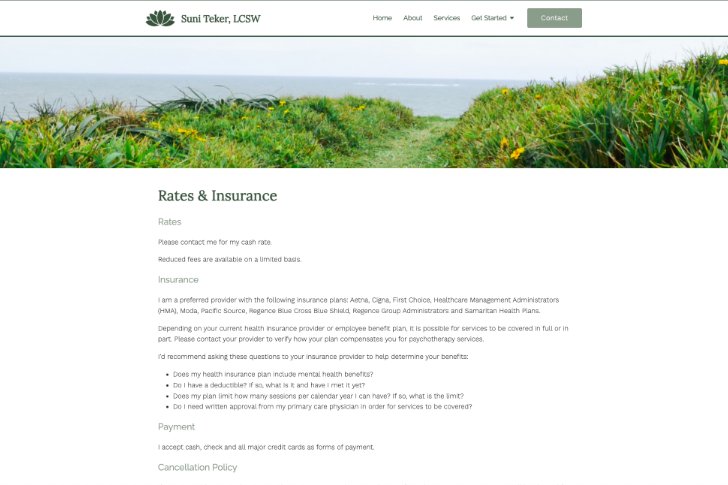
7: Suni Teker, LCSW
Website: Suni Teker, LCSW
Feature to Note has page dedicated to rates and insurance
Suni Teker, LCSW’s website features a section dedicated to the rates and insurance the client may need to consider before booking an appointment with Alexandria Art Therapy. In this way the practice is able to be upfront on their policy’s and what a client may need when submitting paperwork.
By emphasizing the rate, payment, insurance, and policy on this page, it adds another degree of openness and expectations that must be met, which is critical to preserving the clinic’s trust and reputation, giving potential clients greater confidence in choosing this practice.
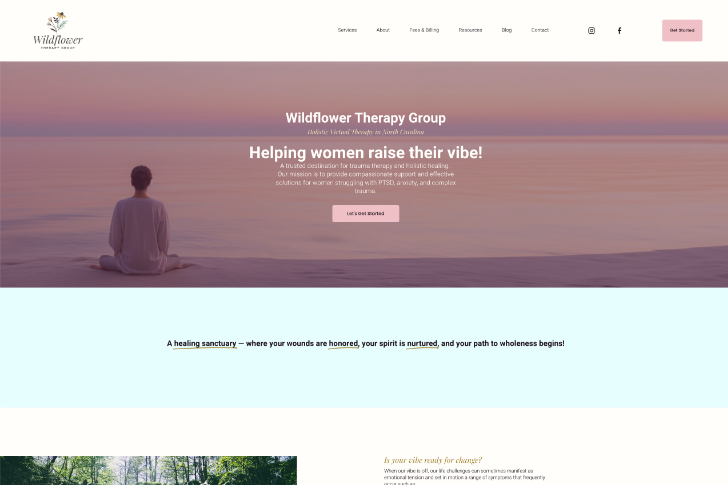
8: Wildflower Therapy Group
Website: Wildflower Therapy Group
Feature to Note
Wildflower Therapy Group’s website engages visitors with pleasant imagery on the homepage. This use of graphics provides a calming aura establishing this place as a safe space as well as highlighting the services offered and their dedication to client care, creating a personal connection with potential clients.
Graphic content is a powerful tool for conveying information quickly and effectively, and it helps to humanize the practice by showcasing the friendly and professional environment—a great way to attract more clients. By using graphics, the practice can better capture the attention of visitors, increase engagement, and make a lasting impression.
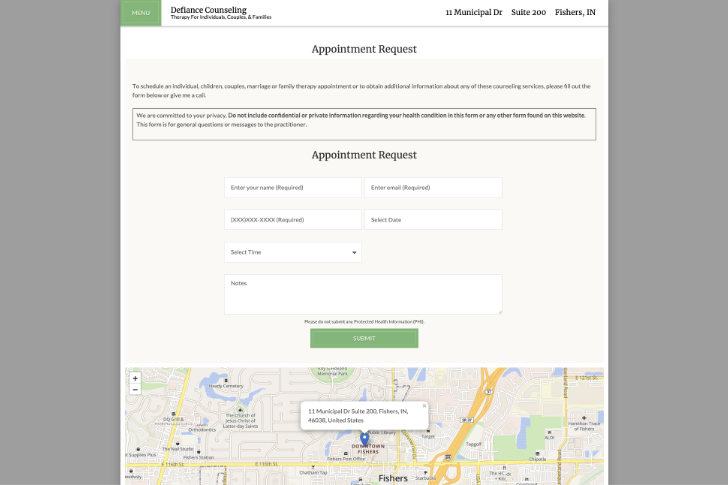
9: Defiance Counseling – Therapy For Individuals, Couples, & Families
Website: Defiance Counseling – Therapy For Individuals, Couples, & Families
Feature to Note appointment request form
Defiance Counseling’s website, like many effective therapist websites, features an easy-to-use appointment request form that streamlines the process for clients to schedule their visits. By providing a straightforward and user-friendly form, the website ensures that potential clients can quickly and easily book appointments without the hassle of phone calls or emails.
This convenience enhances the user experience for client receiving and can lead to higher conversion rates, as clients are more likely to complete the booking process when it is simple and accessible. The clear instructions and responsive design further contribute to a seamless and efficient appointment scheduling experience.
Best Practices for Client-Focused Design in Therapist Websites
Understanding Your Client’s Needs
Knowing your target audience is the first step in creating a client-focused website. Understand their needs, preferences, and common concerns. Tailor the website content and design to address these aspects, ensuring that clients feel understood and valued.
Create your therapy site with an ideal client persona in mind, a conglomeration of traits, needs, and wants of your best clients and potential clients you want to attract. Think about the chiropractic services they are looking for, the important elements that will resonate: a professional looking simple layout, attractive images, pleasing color scheme, testimonials section.
Using a persona can help guide you to your ideal potential client, and lead to more positive reviews because your marketing efforts are more focused to create and deliver a specific experience.
Prioritizing Accessibility
Accessibility is crucial for ensuring that all users, including those with disabilities, can navigate and use the website effectively. Implement features such as alt text for images, keyboard navigation, and screen reader compatibility to make the website accessible to everyone.
Color scheme, font choices, and design inspiration also become a very important way to convert visitors. It is important in an effort to stand out to still employ best practices for accessibility with these aesthetic elements. There are a number of free online tools to scan your website and flag any accessibility issues.
Using High-Quality Images
High-quality images can significantly enhance user engagement. Use professional images that reflect the practice’s environment, services, and staff. Avoid generic stock photos and opt for images that convey authenticity and professionalism.
A quality, compelling hero image (a full width hero image is ideal) gives your site credibility at first glance. Pair it with a clear and captivating headline and brief description to attract new clients, and introduce them to your various services. Click here to view TherapySites’s entire gallery of website templates specific to chiropractic practices.
Keeping Content Updated
Regularly updating the website content is important for keeping it relevant, informative, and useful for search engine optimization. Ensure that information about services, staff, and contact details is up-to-date. Additionally, consider adding a blog section to share news, tips, and educational articles related to chiropractic care.
Quality, relevant content is a marker of the best chiropractic website, serving current and potential clients, placing in search engine rankings, and drawing more leads
Ensuring Fast Load Times
Website speed is a critical factor for user experience and SEO of any good website. Optimize images, use efficient coding practices, and leverage content delivery networks (CDNs) to ensure fast load times. A slow website can frustrate users and lead to higher bounce rates.
In addition to optimizing images and coding, consider minimizing the use of heavy scripts and plugins that can slow down your site. Regularly monitor your website’s performance using tools like Google PageSpeed Insights or GTmetrix to identify areas for improvement. Implementing these practices not only enhances user experience but also boosts your website’s search engine rankings, as search engines prioritize faster-loading websites.
Conclusion
A client-focused therapy website design is essential for attracting and retaining clients. By enhancing user experience, building trust, and improving conversion rates, a well-designed website can significantly benefit a chiropractic practice. We hope these examples and best practices inspire you to evaluate your own website and implement client-focused design elements.
At TherapySites, we specialize in creating customized, client-focused websites for private practices. In addition to being a website provider, our team of experts understands the unique needs of doctors and their clients, ensuring that every website we design not only looks great but also performs exceptionally well. We are a one-stop online marketing solution.
Whether you need a complete website overhaul or specific enhancements to your existing site, TherapySites can help you achieve your goals and elevate your online presence.

Dani Romero is a therapy and psychology content provider for mental health professionals. Her pieces strive to demystify the digital marketing landscape for therapists and make it easier for them to reach a wider audience. As a lifelong proponent of therapy and mental health services, Dani finds joy in helping those who dedicate their lives to helping others.
Tags:
website designRecent Posts
- Introduction to Digital Therapy Client Education
- How to Create A Therapy Focused Social Media Marketing Calendar
- Marketing for Counselors | 10 Ad Types to Try
- SEO for Therapists: 9 Tips for Ranking Higher on Local Search
- 9 Client Focused Therapy Website Design Examples
- 6 Unethical SEO Shortcuts All Therapists Should Avoid
- 7 Blog Post Ideas for Therapists & Mental Health Professionals
- 10 Step SEO Checklist for Therapy Practices
- 5 Proven Ways A Tailored Therapist Website Can Grow Your Practice
- Navigating The Client Journey: How Online Listings & Reviews Influence Decisions




